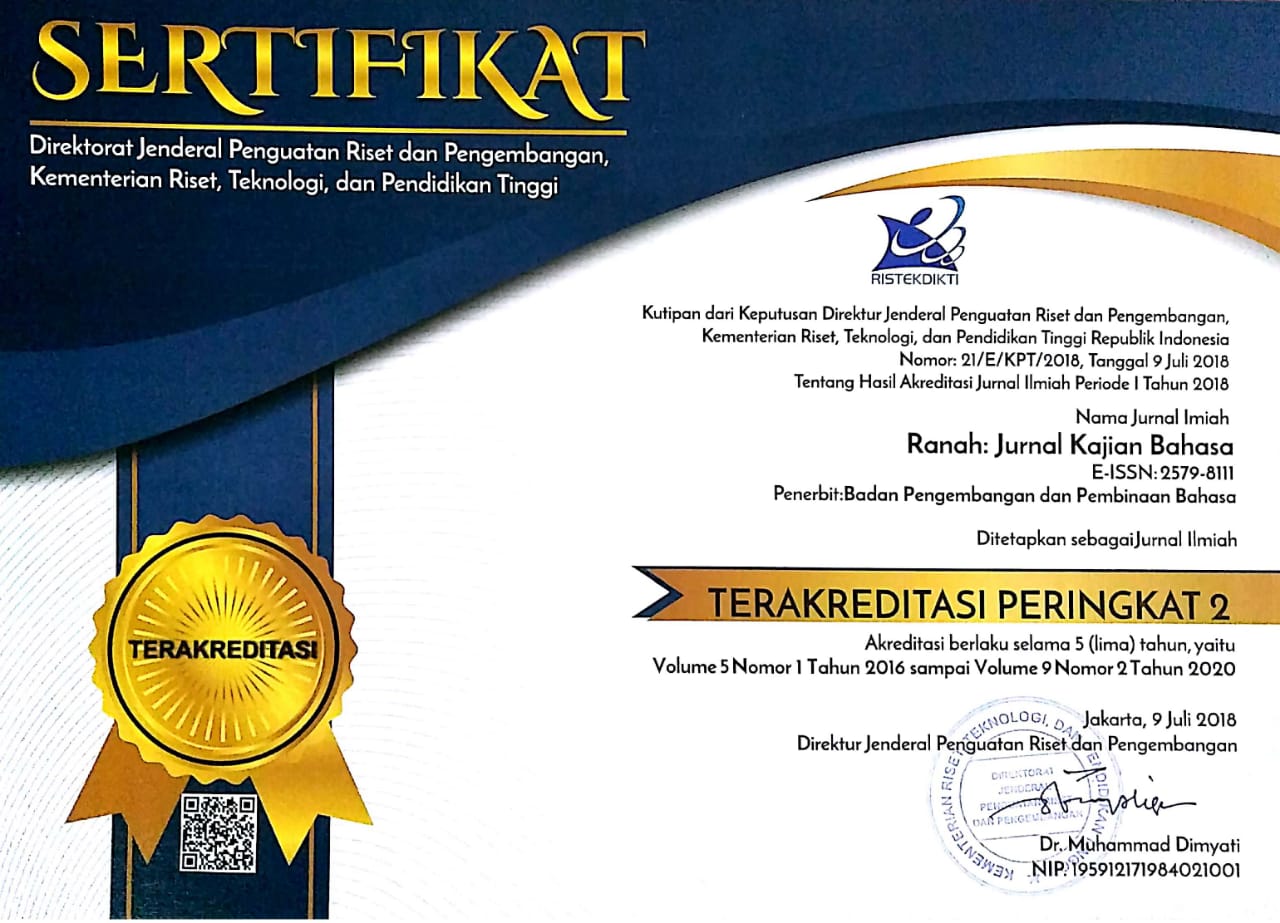Embracing Cultural Threads: A Qualitative Exploration of English Language Teaching Materials Within an Intercultural Perspective in an Indonesian Multilingual Context
Abstract
This study aimed to investigate the selection, adaptation and use of English language teaching and learning (ELTL) resources from an intercultural perspective (Liddicoat & Scarino, 2013) in order to provide greater sensitivity to the local context. In recent decades, scholars in the field have attempted to move towards the inclusion of local content in ELTL, including in Indonesia, in order to challenge the 'native speaker' paradigm, which has been criticized for lacking sensitivity to the local context. However, little research has been conducted to examine the role of resources in providing opportunities for intercultural interaction between students' own languages and cultures and English (as the target language and culture). A case study within a qualitative paradigm, involving document analysis and an in-depth teacher interview, was conducted at an international university in Indonesia. Thematic analysis of the data revealed that the selection, adaptation and use of resources that invited attentiveness to language and beyond, and that took into account students' 'lifeworlds' ('home cultures and languages, and the trajectory of experiences, interests, motivations and values developed from them' [Liddicoat & Scarino, 2013]), provided engagement and meaningfulness in ELTL in the local context. The study also showed that 'both the range of texts and what teachers do with them' (Kohler, 2020) were fundamental to providing meaningful ELTL experiences in the local context.
Abstrak
Penelitian ini bertujuan untuk menyelidiki pemilihan, adaptasi, dan penggunaan materi pengajaran dan pembelajaran bahasa Inggris (ELTL) dari perspektif lintas budaya (Liddicoat & Scarino, 2013) untuk memberikan kepekaan yang lebih besar terhadap konteks lokal. Dalam beberapa dekade terakhir, para ahli di bidang ini telah mencoba untuk bergerak menuju inklusi konten lokal dalam ELTL, termasuk di Indonesia, untuk menantang paradigma 'penutur asli', yang telah dikritik karena kurangnya kepekaan terhadap konteks lokal. Namun, hanya sedikit penelitian yang telah dilakukan untuk meneliti peran materi belajar mengajar dalam memberikan kesempatan untuk interaksi antarbudaya antara bahasa dan budaya siswa dan bahasa Inggris (sebagai bahasa dan budaya target). Sebuah studi kasus dalam paradigma kualitatif, yang melibatkan analisis dokumen dan wawancara mendalam dengan guru, dilakukan di sebuah universitas internasional di Indonesia. Analisis tematik terhadap data menunjukkan bahwa pemilihan, adaptasi, dan penggunaan materi belajar mengajar yang mengundang perhatian terhadap bahasa dan sekitarnya, serta mempertimbangkan 'dunia kehidupan' siswa ('budaya dan bahasa asal, serta lintasan pengalaman, minat, motivasi, dan nilai-nilai yang dikembangkan dari mereka' [Liddicoat & Scarino, 2013]), memberikan keterlibatan dan kebermaknaan dalam ELTL dalam konteks lokal. Studi ini juga menunjukkan bahwa 'baik ragam teks dan apa yang dilakukan guru dengan teks tersebut' (Kohler, 2020) merupakan hal yang mendasar dalam memberikan pengalaman ELTL yang bermakna dalam konteks lokal.
Keywords
Full Text:
PDFReferences
Alwasilah, A.C. (1997). Politik Bahasa dan Pendidikan (p. 8-11). Remaja Rosdakarya.
Atkinson, D. (1999). TESOL and culture. TESOL quarterly, 33(4), 625-654. https://doi.org/10.2307/3587880
Braun, V. & Clarke, V. (2017). Thematic analysis. The Journal of Positive Psychology, 12(3), 297-298. https://doi.org/10.1080/17439760.2016.1262613
Budairi, A. (2018). Traces of linguistic imperialism enacted through discursive strategies in ELT textbooks in Indonesia. English Language Teaching Educational Journal, 1(2), 49-64. https://doi.org/10.12928/eltej.v1i2.581
Creswell, J.W. (2013). Qualitative inquiry and research design: choosing among five approaches (3rd ed.). Sage.
Dardjowidjojo, S. (2000). English Teaching in Indonesia. EA Journal, 18(1), 22-30. https://doi.org/10.1111/1467-9639.00010
Elshadelin, G. & Yumarnamto, M. (2020). Cultural contents in two English textbooks in Indonesia: representations and sources of culture. Beyond Words, 8(2), 60-77. https://doi.org/10.33508/bw.v8i2.2511
Emerson, R. W. (2015). Convenience sampling, random sampling, and snowball sampling: how does sampling affect the validity of research? Journal of Visual Impairment and Blindness, 109(2), 164-168. https://doi.org/10.1177/0145482X1510900215
Hamied, F.A. (2012). English in multicultural and multilingual Indonesian education. Springer Netherlands. https://doi.org/10.1007/978-94-007-4578-0_5
Kern, R. & Liddicoat, A.J. (2008). De l'apprenant au locuteur/acteur'. In G. Zarate, D. Levy & C. Kramsch (Eds), Précis de plurilinguisme et du pluriculturalisme (p. 27-24). Paris Editions des archives contemporaines.
Khaerudin, T. & Chik, A. (2021). Evaluating support for learner autonomy in ELT textbooks. The Journal of ASIA TEFL, 18(1), 39-56. https://doi.org/10.18823/asiatefl.2021.18.1.3.39
Kohler. M. (2015). Teachers as mediators in the foreign language classrooms. Channel View Publications. https://doi.org/10.21832/9781783093076
Kohler, M. (2019). Language education policy in Indonesia: a struggle for unity in diversity. In A. Kirkpatrick & A.J. Liddicoat (Eds), The Routledge international handbook of language education policy in Asia (1st ed.). Routledge. https://doi.org/10.4324/9781315666235-20
Kohler, M. (2020). An intercultural orientation to languages education: Expanding identity repertoires. Proceeding of the 1st international conference on language, literature, and arts education (ICLLAE 2019), 1, 1-9. https://doi.org/10.2991/assehr.k.200804.001
Kramsch, C. (1988). The cultural discourse of foreign language textbooks. In A Singerman (Ed), Toward a new integration of language and culture. Northeast Conference.
Kramsch, C. (2014). Teaching foreign languages in an era of globalization: introduction. Modern Language Journal, 98(1), 296-311. https://doi.org/10.1111/j.1540-4781.2014.12057.x
Kramsch, C. & Zhu, H. (2016). Language and culture in ELT. In G. Hall (Ed), The Routledge handbook of English language teaching. Routledge. https://doi.org/10.4324/9781315676203-5
Larson, K. (2014). Critical pedagogy(ies) for ELT in Indonesia. TEFLIN Journal, 25(1), 122-138. https://doi.org/10.15639/teflinjournal.v25i1/122-138
Lauder, A. (2008). The status and function of English in Indonesia: a review of key factors. Makara, 12(1), 9-20. https://doi.org/10.7454/mssh.v12i1.128
Leung, C. & Scarino, A. (2016) Reconceptualizing the nature of goals and outcomes in language/s education, The Modern Language Journal, 100, 81-95. https://doi.org/10.1111/modl.12300
Liddicoat, A.J. & Scarino, A. (2013). Intercultural language teaching and learning. Willey-Blackwell. https://doi.org/10.1002/9781118482070
Manara, C. (2014). "That's what worries me": Tensions in English language education in today's Indonesia. International Journal of Innovation in English Language Teaching and Research, 3(1), 21-35.
Marcellino, M. (2008). English language teaching in Indonesia: A continuous challenge in education and cultural diversity. TEFLIN Journal, 19(1), 57-69. https://doi.org/10.15639/teflinjournal.v19i1/57-69
Merriam, S.B. (1988). Case study research in education: a qualitative approach, Jossey-Bass.
Monica, S., Danim, S., Kristiawan, M. & Khairi, A. A. (2023). Teachers' perceptions: the benefits and weaknesses of local and foreign cultural representation in English textbooks in Indonesia. Jurnal Pendidikan, 15(1), 1009-1017. https://doi.org/10.35445/alishlah.v15i1.2723
Novita, D. & Purwati, O. (2021). Incorporating culture and textbook adaptation practice for promoting intercultural competence in ELT: teachers' perspectives. Journal of English Educators Society, 6(1), 96-104. https://doi.org/10.21070/jees.v6i1.1059
Richards, K. (2009). Trends in qualitative research in language teaching since 2000, Lang. Teach., 42(2), 147-180. https://doi.org/10.1017/S0261444808005612
Shalehah, T. O., Rohadi, T. & Yavani, Z. (2020). A comparison of 4Cs' praxis in two recommended English textbooks for senior high school in Indonesia. ELT-Echo, 5(1), 55-65. https://doi.org/10.24235/eltecho.v5i1.6720
Stake, R. E. (1995). The art of case study research. Sage.
Stake, R. E. (2005). Qualitative case studies. In N. K. Denzin & Y. S. Lincoln (Eds.), The Sage handbook of qualitative research (3rd ed, pp. 443-466). Sage.
Stratton, S. J. (2021). Population research: convenience sampling strategies. Prehospital and Disaster Medicine, 36(4), 373-374. https://doi.org/10.1017/S1049023X21000649
Suryadinata, L. (2018). Pancasila and the challenge of political Islam: past and present, Cambridge University Press. https://doi.org/10.1355/9789814818681
Tika, A. & Fithriani, R. (2023). Multicultural competence in English language pedagogy: an analysis of cultural values in Indonesian primary ELT textbooks. Language Circle, 17(2), 268-275. https://doi.org/10.15294/lc.v17i2.42572
Widodo, H. P. (2016). Language policy in practice: Reframing the English language curriculum in the Indonesian secondary education sector. In R Kirkpatrick (Ed.), English language education policy in Asia (pp. 127-151). Springer International Publishing. https://doi.org/10.1007/978-3-319-22464-0_6
Widodo, H. P. (2017). A critical micro-semiotic analysis of values depicted in the Indonesian Ministry of National Education-endorsed secondary school English textbook. In H. P. Widodo., M. R. Perfecto., L. V. Canh & A. Buripakdi (Eds), Situating moral and cultural values in ELT materials: the Southeast Asian context. Springer. https://doi.org/10.1007/978-3-319-63677-1_8
Wolcott, H. F. (1994). Transforming qualitative data: description, analysis, and interpretation. Sage.
Yin, R. K. (2009). Case study research: design and methods (4th edn). Sage.
DOI: https://doi.org/10.26499/rnh.v12i2.6840
Refbacks
- There are currently no refbacks.








